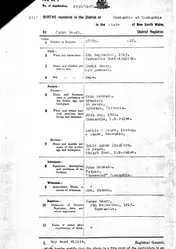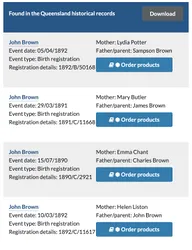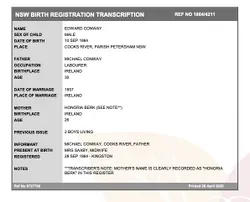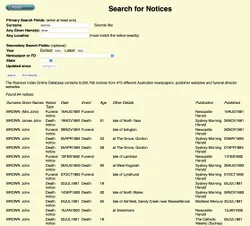
Official Australian birth, death, and marriage (BDM) records, also known as vital records, are registered and held by each of the country's six states (New South Wales, Victoria, Queensland, Tasmania, South Australia, and Western Australia) and two federal territories (Northern Territory and the Australian Capital Territory). Registration usually depends on where the event took place.
All states and the ACT have free searchable online indexes to "historic" births, deaths, and marriages registered in their respective jurisdictions. The date range of publication depends on legislation enacted in each State or Territory, so the coverage of indexes varies between each jurisdiction--see details below. Generally, "recent" DBM records can only be accessed by specified Next of Kin after written application. This is in line with relevant legislation in each jurisdiction designed to protect people from unjustified intrusions on their privacy[1].
For these jurisdictions, fees are payable if a hard (printed) copy of the registration certificate is required. Typically this is made available by mail. In some cases an online image (PDF) version may also be available for immediate download.
The Northern Territory does not have a free online search facility. Official BDM certificates can be ordered online; however, the researcher needs to know the record details first.
Information contained in Australian birth, death, and marriage recordsInformation contained in Australian birth, death, and marriage records
Where online indexes are available, they usually include basic details, such as:
- First/Last Name
- Mother/Father Name
- Place the Event was Registered
- Year of Registration of the Event
- Registration Number of the Event
Note that the Place of Registration may be different from where the Event occurred. Likewise, the Year of Event Registration may be different from the Year the Event took place, for example, a birth late in a year may not be registered until the following year.
Official BDM certificates will contain more details than the online indexes. This additional information might include:
- Actual Date of the Event (day/month/year)
- Sex of Person
- Father/Mother Occupation
- Father/Mother Place of Birth
- For Birth Certificates:
- Previous Issue (the number of children previously born to the mother, sometimes individually named and their ages stated)
- Present at Birth (doctor/midwife in addition to mother)
- For Death Certificates
- Cause of Death
- Medical Practitioner certifying the Cause of Death
- Place of Burial
- Date of Burial
- Undertaker/Witnesses
- For Marriage Certificates
- Religion(s) of Persons Married
- Witnesses to the Marriage
- Minister/Celebrant of the Marriage
The following is a summary of the key features of BDM records access in each of Australia's eight jurisdictions.
Birth, marriage, and death records in New South Wales (NSW)Birth, marriage, and death records in New South Wales (NSW)

According to the NSW DBM Registry, it was not compulsory to register a birth, death, or marriage in NSW until 1856 and written forms did not come into use until 1918. This means that some records may be missing key details, or missing entirely[2]. Before 1856, baptisms, marriages, and burials were recorded in Church registers. The NSW civil registration system also included for the Australian Capital Territory (also known as the Federal Capital Territory), Northern Territory, and Queensland for that period that these areas were under NSW administration:
The NSW historical indexes to Births, Deaths and Marriages are searchable for free online at the NSW Registry of BDM website.
These indexes are freely accessible for genealogical research for:
- Birth records more than 100 years ago
- Marriage records more than 50 years ago
- Death records more than 30 years ago
Birth, marriage, and death records in the Australian Capital Territory (ACT)Birth, marriage, and death records in the Australian Capital Territory (ACT)
The Australian Capital Territory began registering Births, Deaths and Marriages on 1 Jan 1930 under the (Federal Capital Territory Registration of Births, Deaths and Marriages Act, 1929). Prior to 1930, all ACT births, deaths and marriages were registered in NSW. Registration in this area is most likely, but not exclusively, in the district of Queanbeyan, adjacent to the ACT.
The ACT Government through their Access Canberra website provides the following historical indexes online, in the form of spreadsheet (XLS) or PDF file formats[3]. These are generally accessible where a birth occurred more than 100 years ago, a marriage occurred over 75 years ago, or a death occurred more than 30 years ago.
Birth, marriage, and death records in Victoria (Vic)Birth, marriage, and death records in Victoria (Vic)
The Victorian registry of BDM records, dating back to 1836, can be searched for free online. No identification restrictions apply for:
- Birth records more than 100 years ago
- Marriage and Registered relationship records more than 60 years ago
- Death records more than 30 years ago
The results are in the form of an extract of the record and the researcher can then proceed to purchase full details by mail or as a downloadable PDF image format.
Birth, marriage, and death records in Queensland (Qld)Birth, marriage, and death records in Queensland (Qld)

The Old Registry of Births, Deaths, and Marriages keeps records of BDM events that took place in Queensland from 1829 onwards. However compulsory registration of these life events in the state only dates from 1856 so records earlier than that are incomplete. The Registry provides a free online search tool which covers:
- Birth records more than 100 years ago
- Marriage records more than 75 years ago
- Death records more than 30 years ago
After viewing search results, you can purchase a certificate and obtain all the information available.
Birth, marriage, and death records in Tasmania (Tas)Birth, marriage, and death records in Tasmania (Tas)
Official registration for births, deaths, and marriages in Tasmania began in December 1838 and even then not all BDM events were registered. Often it is only churches that hold the only information this information for the early years of the Tasmanian colony. However, some surviving records on marriages and burials for the period 1803-1838 have been incorporated into the official records. Furthermore, Tasmanian registrations generally give less information than other Australian states.
Indexes to Tasmanian BDM records are centralized in a single online database, the Tasmanian Names Index, on the Libraries Tasmania website. They include:
- Registry of Births, Deaths, and Marriages
- Divorces (1861-1920), Petitions for divorce in the Tasmanian Supreme Court
- Marriages (1803-1899), People who married in Tasmania
- Births (1803-1933), People born in Tasmania including some baptisms collected by the Registrar General (for 1900-1933 details only for baptisms)
- Convict permissions to marry (1829-1857), Convicts applying to marry free people or other convicts
- Deaths (1803-1933), People who died in Tasmania including some burial records collected by the Registrar General (1900-1933 records for burials only)
In addition to the Library Tasmania's online subscription databases, more BDM information is available for access within the Library on CD-ROMs.
Birth, marriage, and death records in South Australia (SA)Birth, marriage, and death records in South Australia (SA)

The SA Government Office holds the physical BDM records. However, Genealogy SA has a free online search facility available for these records. The search function also includes links to newspaper obituaries and notices. Copies of results found from Genealogy SA (in the form of scans of their microfiche records) can be ordered for a fee. The online search of BDM will provide a registration number which can also be used to order records from the SA Government Office.
Information available includes:
- Marriages 1836 to 1856 - 9,600 registered and unregistered South Australian marriages up to 1856 including those before civil registration (mid-1842)
- Deaths 1836 to 1855 - 13,000 registered and unregistered deaths in South Australia up to 1855 including those before civil registration. Genealogy SA does not hold original death registrations from 1968 to 1972, only index records, therefore it cannot transcribe death registrations between 1968 to 1972.
- South Australian Cemeteries - Deaths and burials - Death & burial information up to 1855 at early SA cemeteries, and up to recent times at several selected cemeteries together with some SA lone graves. Headstone photographs are sometimes included
- Colonial South Australian Pioneers - Historical passenger lists, births, marriages & deaths from 1836 to the 1850s
Birth, marriage, and death records in Western Australia (WA)Birth, marriage, and death records in Western Australia (WA)
The WA registry offers a free online historic index of births, deaths, and marriages from 1841.
This online registry records cover:
- Birth records more than 100 years ago
- Marriage records more than 75 years ago
- Death records more than 30 years ago
As with other Australian states, hard copies of full BDM certificates can be ordered online using the registration details obtained from the online indexes.
Birth, marriage, and death records in the Northern Territory (NT)Birth, marriage, and death records in the Northern Territory (NT)
Administration of the area now known as the Northern Territory was by NSW until 1863. For births, deaths, and marriages from the beginning of Civil Registration in 1856 to 1863 researchers need to access NSW registry records. Between 1863-1870 administration of the Northern Territory was from SA and civil registration of births, deaths, and marriages for that period can be found in SA records.
No freely available online index to births, deaths, and marriages in the NT currently exists besides those that may be included in the registers of NSW and SA. To request a search, you must contact the NT Births, Deaths and Marriages office to arrange the search, provide identification documents and pay for the search.
Further researchFurther research

Family Trees created and maintained by other MyHeritage members offer an invaluable tool to find information on people of interest to you who also appear in their trees. This information will usually include BDM details. However it's highly desirable to confirm vital records obtained in this way by reference to that available from in official sources to ensure accuracy, especially for the key people you are researching.
Outside MyHeritage, the National Library of Australia provides a comprehensive guide to BDM records available from all Australian jurisdictions.
An alternative to official BDM certificates in Australia, it is possible to use a licensed commercial transcription service to obtain a copy of the desired certificate. These transcripts contain the same information as the official certificate and typically can be processed more quickly and lower cost than through the various State and Territory Registries. They are probably sufficient for family history research but of course, not for official or legal purposes. They can be found using your preferred online search engine using a term such as "Australia Birth Death Marriage Transcription Service".
Explore more about birth, marriage, and death records in AustraliaExplore more about birth, marriage, and death records in Australia

Other sources of BDM information, not as complete as official certificates or transcribed copies but still useful, include:
- Australian birth, marriage, and death records on MyHeritage
- Australian Resources on MyHeritage, webinar with Shauna Hicks on the MyHeritage Knowledge Base
- Tips & Tricks for Researching in Australian Archives, webinar with Shauna Hicks on Legacy Family Tree Webinars
- Trove, Australia's free online research portal. Trove is a collaboration between the National Library of Australia and hundreds of Partner organizations containing a wealth of diverse information. It includes a powerful search engine providing access to hundreds of Australian newspaper and magazine archives spanning more than 150 years. Searches can be limited by topic, such as Family Notices, which covers public notices of births, deaths, marriages and other family events. These notices were the main way people let their family, friends and acquaintances know of such events before the era of social media.
- The Ryerson Index is a free index to death notices appearing in Australian newspapers. The date range covered extends from the Sydney Gazette of 1803 up to newspapers published until almost the present time. The Index also includes many funeral notices, and some probate notices and obituaries.
- The Australian Cemeteries Index provides an online searchable database of graves in over 600 Australian cemeteries, covering almost 3 million headstone inscriptions and 1 million images. Headstones will usually include the date of death and sometimes other valuable BDM information.
Birth, Marriage & Death
Death, Burial, Cemetery & Obituaries
- Australia Obituary Index from OldNews.com? 28,227,580 records
- Australia Death Notices, 1860-2019 7,060,358 records
- Australia, Victoria Death Index, 1836-1985 6,830,782 records
- Australia, New South Wales Death Index, 1787-1986 5,724,732 records
- Australia, Cemetery Inscriptions 1,264,385 records
- Australia, Queensland Funeral Home and Burial Records 633,015 records
- Australia, Index of Burials, 1900-2019 438,586 records
- Australia, South Australia, Adelaide Burials 282,623 records
- Australia, Brisbane Burials and Cremations 279,276 records
- Australia Deaths and Burials, 1816-1980 146,891 records
- Australia, Brisbane Hospital Death Records 52,885 records
Birth Records
- Australia, Victoria Birth Index, 1837-1920 5,921,996 records
- Australia, New South Wales Birth Index, 1787-1916 4,913,069 records
- Australia, Births and Baptisms, 1792-1981 1,566,812 records
Marriage & Divorce
- Australia, New South Wales Marriage Index, 1788-1966 3,679,221 records
- Australia, Victoria Marriage Index, 1837-1942 1,695,063 records
- Australia, Marriages, 1810-1980 433,908 records
- London Marriage Licences 1521 - 1869 853 records
Church Records
- Sydney Diocesan Directory 1920 542 records
- Sydney Diocesan Directory 1919 522 records
- Sydney Diocesan Directory 1918 518 records
- Sydney Diocesan Directory 1917 502 records
References
- ↑ Births Deaths and Marriages Victoria, Department of Justice and Regulation, State Government of Victoria. (2023, May 4). Privacy policy. Births Deaths and Marriages Victoria
- ↑ NSW Government Birth, Death and Marriage Registry. (2023, June 16). Family ancestry search guide. NSW Government
- ↑ Apply for a Birth, Death or Marriage certificate. Access Canberra

